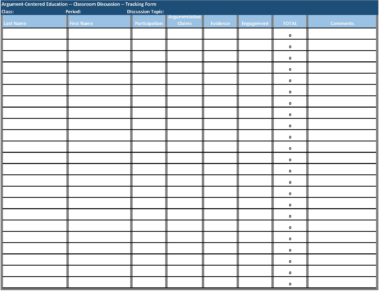
Assessing Discussion: Leveraging Speaking and Listening for Learning
Education standards are increasingly acknowledging the importance of speaking and listening in the classroom as a mechanism for learning. The Common Core puts forward an unprecedentedly detailed set of standards for students’ classroom discussions. These two examples are representative:
CCSS.ELA-Literacy.SL.8.1.c
Pose questions that connect the ideas of several speakers and respond to others’ questions and comments with relevant evidence, observations, and ideas.CCSS.ELA-Literacy.SL.8.1.d
Acknowledge new information expressed by others, and, when warranted, qualify or justify their own views in light of the evidence presented.
The central motivation of scientists and engineers is to put forth what they believe is the best explanation for a natural phenomena or design solution, and to verify that representation through well-wrought arguments.
This all makes sense and flows logically from the quadrangle basis of literacy. Students can only learn and express their learning through four fundamental functions, after all: students read, listen, write, and speak. If solving problems on paper or in a program qualifies as writing (and why shouldn’t it?), there isn’t anything students do to learn or demonstrate their learning that isn’t a variation of these four functions. Speaking and listening make up fully half of this quartet. It makes every bit of sense to treat classroom speaking and listening — classroom discussion — as a fully academic learning platform.
Doing so necessitates a system of assessment, of course. If speaking and listening in classroom discussion is to be placed on an equal footing with writing and reading, is it is essential that educators have the means of assessing learning that is attained and demonstrated through classroom discussion. Argument-Centered Education has a universal assessment rubric and assessment tracking form that can be used for classroom discussions, across disciplines and grade levels. The documents can also be adapted and tailored to particular unit content, or additional specific skills being taught and learned.


From our experience helping partner schools use these discussion assessment instruments in classrooms across disciplines, we would offer several tips to get the most out of them.
Consider targeting specific components
You don’t have to assess for all four components for each discussion. Consider announcing to the class that for the next discussion one or two of the components will be the focus and will be assessed. You might consider introducing the assessment system with the gradual inclusion of components: for the first two discussions, only participation will be assessed; for discussions three and four, participation and claims will be assessed; for the fifth and sixth, participation, claims, and evidence; and for the seventh and eighth, all four components.
Continuity and timeliness are important
Students will not respond on a dime to an instrument like this discussion assessment system. They will gradually elevate the academic seriousness with which they approach and take part in classroom discussions in response to this system, but only if it is implemented with continuity, consistently over time, so that they have a full opportunity to see how it works, what work it expects and rewards, and how you place it within the larger classroom and curricular context. Students should also get their discussion assessment the day after a discussion, so that the discussion is fresh enough to them that they can connect their performance in it to the assessment.
Adapt the instruments to suit your content and skills objectives
The assessment rubric and assessment tracking form are designed to be both universal and readily adaptable. You should add or replace components to assess that are aligned with your instructional objectives, while retaining their overall structure and argument-based direction.
Keep the assessment process simple
One way to make the assessment process as quick and simple as possible is to create tracking forms with the names of the students in each class and then simply copy these forms for each discussion. You should not have to enter names more than once. Another way is to fill in numbers quickly at the end of the day, or shortly after a class, with no comments, just numbers. The assessment rubric descriptors provide enough information to students to help them understand what they are doing well in discussion and what they need to work to improve.

